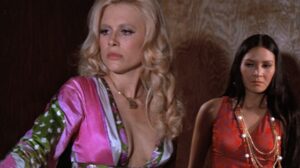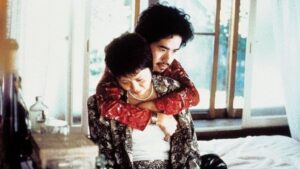![]()
Peter Pan (1924) Directed by Herbert Brenon
Just like the title character, Herbert Brenon’s film is nimble, joyous and magical. This adaptation of the spellbinding masterpiece of the mythical boy who refused to grow up, produced by Famous Players-Lasky and distributed by Paramount Pictures is not only the best, most faithful film adaptation of J.M. Barrie’s Peter Pan, but also one of the all-time classics of American silent fantasy cinema. And my personal favorite among the animated and live action adaptations in the film medium; I mean it’s the only real cinema version among all of them, so my unconditional love for it is self-explanatory. But apart from being the best for its distinctly beautiful visual architecture, it is also the sweetest and most heartfelt of them all.
The polished screenplay written by Willis Goldbeck makes the wise literary move of retaining the entire moral corpus of J.M. Barrie’s play and developing it with an organic maturity through the perceptive direction of Herbert Brenon, who clearly aims for a perfect balance between melancholy and bliss in his film. In this graceful mood, the narrative moves forward with the same reckless infantile zest of a child just savoring the first stage of life, yet the lovely and magical staging that embraces the precocious ideals of an adventurous child never loses the adult sentiment nor the moral discernment of the underlying themes that abound in the childlike gaiety of these fundamentals. As a silent film, the story benefits enormously from the silent nature of the visuals, for being a story steeped in existentialist concerns – I have always believed that Peter Pan is one of the few tales capable of engendering conflicting moral questions of cosmic proportions in children – it can take advantage not only of the candor of our mother tongue – emotions conveyed only with the human face – but it can also employ the physical intimacy of the mise en scène as a polymorphous metaphor.
The film has many sequences that may very well exemplify the reasons why this adaptation is so successful in transposing J.M. Barrie’s play to the big screen and yet not lose any of its punch or its thoughtful motifs. But I would like to keep just as a perfect illustration of this the groundbreaking performance of Betty Bronson playing the eternal child, Peter Pan. A female playing Peter Pan and boy does she deliver a tremendous performance; she is Peter Pan. Betty Bronson’s playful, mischievous countenance with the precise, prematurely delicate features of a cocky but good-natured adolescent, her curly hair shiny but unruly, and her bouncy, high-spirited movements of a hyperactive little boy is the flesh-and-blood picture I visualize of Peter Pan. But that’s not all what makes Betty Bronson’s Peter Pan the best romantic incarnation of the sweet but uncompromising figure that is the character created by J.M. Barrie. Being a male character played by a girl, the character’s mannerisms have a certain effeminate grace, that is inevitable, but they add much to Peter Pan’s adamant, boyish personality, as they give the impression that he is truly a boy who has spent an eternity being a boy, to the point that he has adopted both hybrid traits -masculine and feminine- thus showing himself as an honest embodiment of both the feminine and masculine child who doesn’t want to grow up. This is the only film about Peter Pan that subverts the individual male normative portrayal of the character, now both girls and boys can identify with Betty Bronson’s Peter Pan as it shares the distinct sensibilities of both genders.
Herbert Brenon incorporates in his film virtually all the classic, most memorable highlights of the tale; you get the beatific mermaids, mythical landscape shots of Neverland, Peter’s insubordinate shadow, epic sword duels between the lost boys and Captain Hook’s pirates, and of course you have Tiger Lily played by a winsome, very young Anna May Wong. However, Brenon’s direction nor the deep staging captured magnificently by James Wong Howe are as invested in the magical affair as they are in portraying Peter Pan as a tragic, profoundly wistful figure. Peter Pan cackles, jumps playfully, kisses without even knowing what a kiss is, and soars cheerfully, but the solemn minutes of introspection that Herbert Brenon provides depict an inwardly sad, sometimes alienated, sometimes nostalgic Peter Pan. This is the film that truly fathoms the intricate mythology behind the character of Peter Pan, and Betty Bronson translates his immaturity, conceit and selfishness into a poignant lesson about the importance of embracing the impermanence of life. Mary Brian also gives an essential performance as the gentle, motherly Wendy, who symbolizes the grown-up, rational contrast that Peter Pan consistently eschews. The latter sees Wendy’s affection for him as a maternal love, she sees Peter romantically, yet he is too blinkered in his childishness to realize it.
The film is powerfully touching when you least expect it, yes of course the ridiculously thrilling, balletic sword-fighting sequences between Peter and Captain Hook (played wonderfully by Ernest Torrence) are solid entertainment, and the superb animal suit acting of George Ali playing Nana the dog and the crocodile is also entertainment of the highest order, but for me it’s the emotionalism isolated to all the fantasy pageantry that stands out more than anything else. This works because Herbert Brenon’s film is the only Peter Pan film that has been treated with both a childlike and an adult sensibility. Just watch the moving scene of Peter Pan sneaking around seeing Wendy’s mother mournfully playing the piano and you will understand the formidable tear-jerking proportions that this remarkable motion picture is capable of pulling off.







